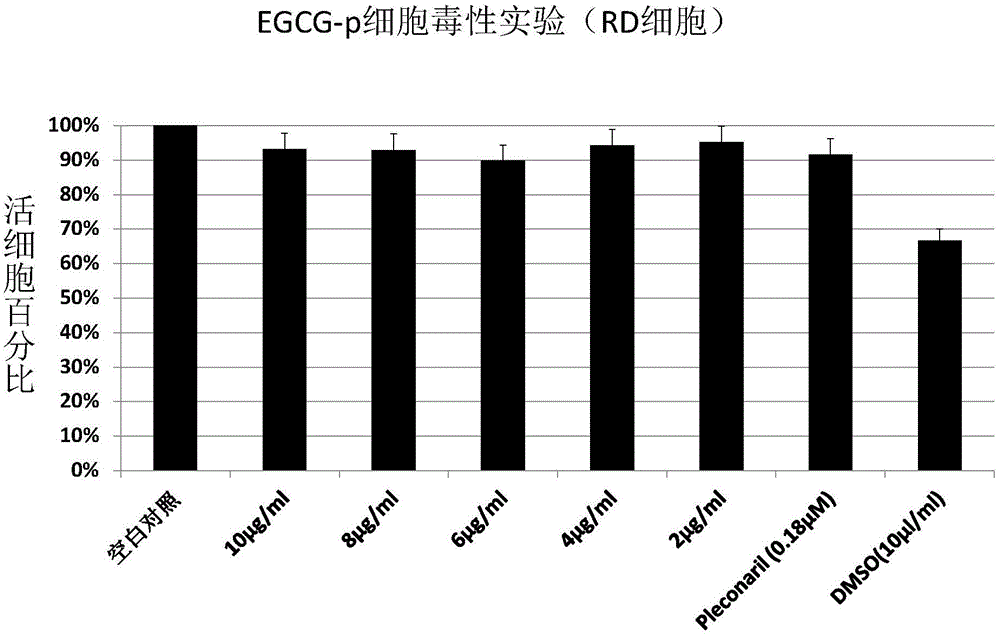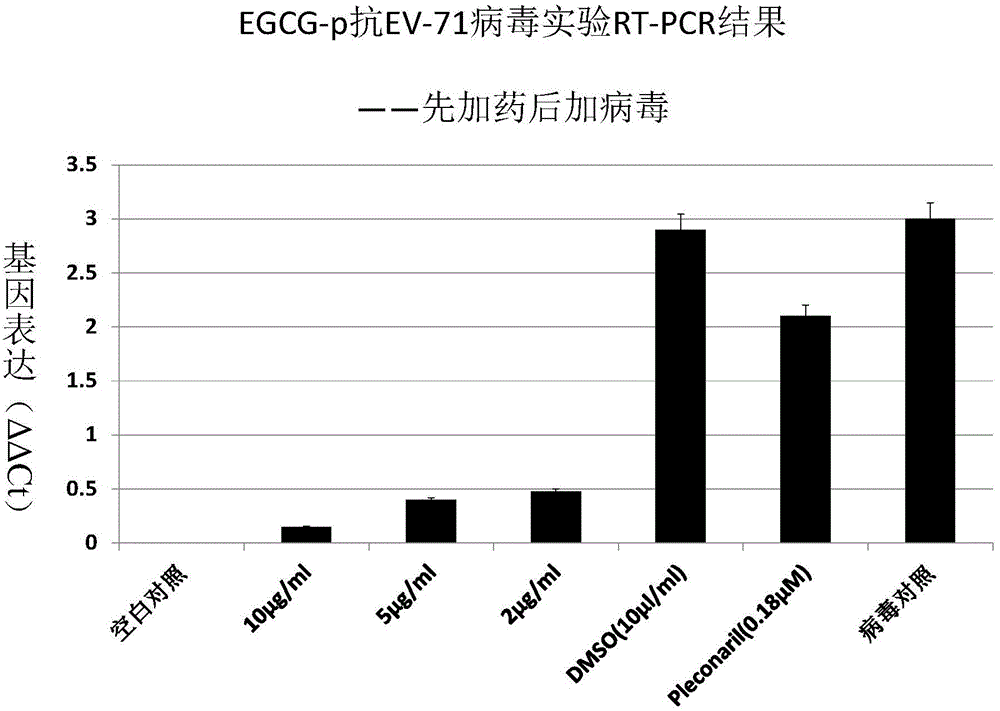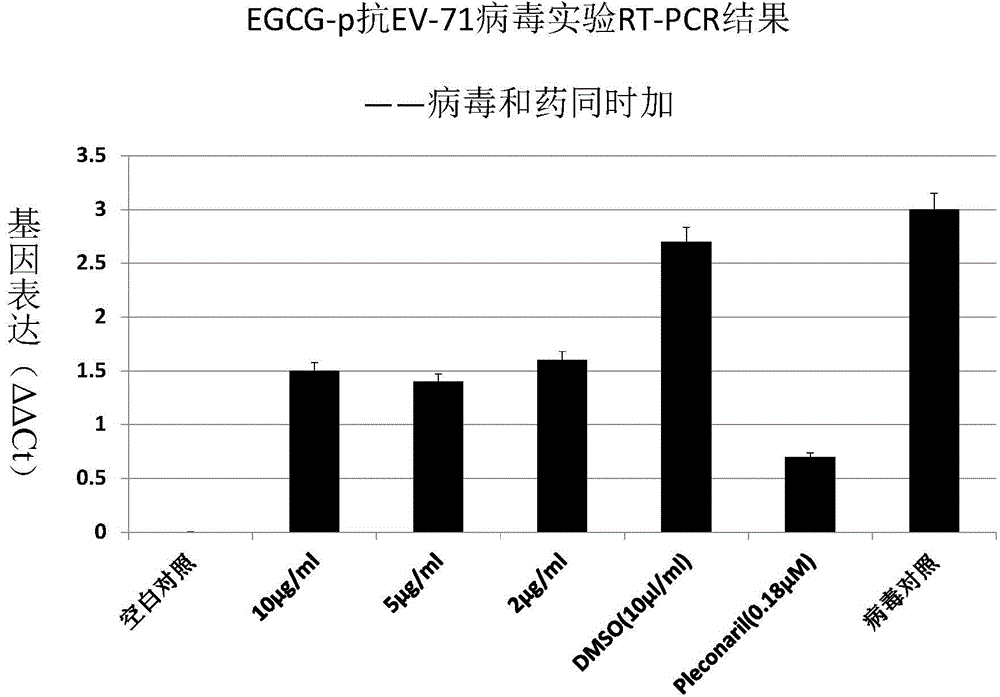Application of EGCG palmitate in preparing medicines for treating or preventing human enterovirus 71 infection
A palmitate, enterovirus technology, applied in antiviral agents, drug combinations, digestive systems, etc., can solve the problems of prevention and treatment that have not yet been mentioned and applied, and achieve high yield, convenient material acquisition, and convenient use. Effect
- Summary
- Abstract
- Description
- Claims
- Application Information
AI Technical Summary
Problems solved by technology
Method used
Image
Examples
Embodiment 1
[0038] Example 1 Toxicity determination of EGCG palmitate to host cells
[0039] When the RD cells cultivated for 24-48 hours are almost covered with a single layer, discard the cell culture medium, add trypsin to digest, transfer to a 96-well sterile cell culture plate, 100 μl per well (1*10 5 cell / ml, the same below). Place it in a cell culture incubator for 18-24 hours to make the cells grow into a single layer for later use. Discard the culture medium, dilute the EGCG palmitate stock solution with cell culture medium, and configure five concentration gradients, add different concentrations of drugs into the cell culture wells, 100 μl per well, repeat 3 wells for each concentration, and at the same time Set up cell control wells (do not add drugs, only add cell culture medium), add 100 μl of cell culture medium to each well, and place in a cell culture incubator at 37°C. The toxicity test method of Pleconaril (positive control drug) and DMSO and EGCG palmitate is the same...
Embodiment 2
[0043] Embodiment 2 EV71 is to the mensuration of cell half infection dose (TCID50)
[0044] Transfer the RD cells cultured into a single layer to a 96-well cell culture plate, and place them in a cell culture incubator for 18-24 hours. The virus stock solution was serially diluted 10 times with cell maintenance solution (10 -1 -10 -8 ). Discard the cell culture medium in each well of the RD cultured into a single layer, wash each well with PBS 3 times, add 100 μl of virus dilution solution of different concentrations to each well, absorb at 37°C for 1.5 h, discard the virus dilution solution, and replenish each well. Add 100 μl of cell maintenance solution, 10 replicates for each concentration, and set normal cell control wells (without adding virus). The cytopathic effect (CPE) of each well was observed daily for 3 consecutive days, and the CPE situation was recorded. The titer of the virus was then calculated by the Reed-Muench method. The following is the calculation ...
Embodiment 3
[0048] Example 3 The preventive effect of EGCG palmitate on EV71 virus
[0049] When the RD cells cultured for 24-48 hours are almost covered with a monolayer, the cell culture medium is discarded, digested with trypsin, and transferred to a 96-well sterile cell culture plate, 100 μl per well. Place it in a cell culture incubator for 18-24 hours to make the cells grow into a single layer for later use. Discard the cell culture medium, and dilute the EGCG palmitate stock solution with the cell culture medium to form three concentration gradients required for the experiment. After dilution, add different concentrations of drugs into the cell culture wells, 100 μl per well, each The concentration was repeated for 3 wells, and a cell control well (no virus, no drug, only cell culture medium) and a virus control well (no drug, virus, and culture medium) were set up at the same time, and Pleconaril was used as a positive control drug. After drug incubation for 1 h, discard the supe...
PUM
 Login to View More
Login to View More Abstract
Description
Claims
Application Information
 Login to View More
Login to View More - R&D
- Intellectual Property
- Life Sciences
- Materials
- Tech Scout
- Unparalleled Data Quality
- Higher Quality Content
- 60% Fewer Hallucinations
Browse by: Latest US Patents, China's latest patents, Technical Efficacy Thesaurus, Application Domain, Technology Topic, Popular Technical Reports.
© 2025 PatSnap. All rights reserved.Legal|Privacy policy|Modern Slavery Act Transparency Statement|Sitemap|About US| Contact US: help@patsnap.com



